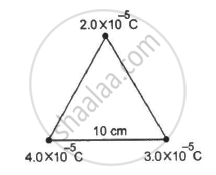Advertisements
Advertisements
प्रश्न
At what separation should two equal charges, 1.0 C each, be placed, so that the force between them equals the weight of a 50 kg person?
उत्तर
Given:
Magnitude of charges, q1 = q2 = 1 C
Electrostatic force between them, F = Weight of a 50 kg person = mg = 50 × 9.8 = 490 N
Let the required distance be r.
By Coulomb's Law, electrostatic force,
\[F = \frac{1}{4\pi \epsilon_0}\frac{q_1 q_2}{r^2}\]
\[ \Rightarrow 490 = \frac{9 \times {10}^9 \times 1 \times 1}{r^2}\]
\[ \Rightarrow r^2 = \frac{9 \times {10}^9}{490}\]
\[\Rightarrow r = \sqrt{\frac{9}{49} \times {10}^8} = \frac{3}{7} \times {10}^4 \text{m} = 4 . 3 \times {10}^3 \text{ m }\]
APPEARS IN
संबंधित प्रश्न
Four point charges qA = 2 μC, qB = −5 μC, qC = 2 μC, and qD = −5 μC are located at the corners of a square ABCD of side 10 cm. What is the force on a charge of 1 μC placed at the centre of the square?
A particle of mass m and charge (−q) enters the region between the two charged plates initially moving along x-axis with speed vx (like particle 1 in the fig.). The length of plate is L and an uniform electric field E is maintained between the plates. Show that the vertical deflection of the particle at the far edge of the plate is qEL2/(2m`"v"_"x"^2`).

Write any two important points of similarities and differences each between Coulomb's law for the electrostatic field and Biot-Savart's law of the magnetic field ?
Does the force on a charge due to another charge depend on the charges present nearby?
Two equal charges are placed at a separation of 1.0 m. What should be the magnitude of the charges, so that the force between them equals the weight of a 50 kg person?
Two charges 2.0 × 10−6 C and 1.0 × 10−6 C are placed at a separation of 10 cm. Where should a third charge be placed, such that it experiences no net force due to these charges?
Two charged particles are placed 1.0 cm apart. What is the minimum possible magnitude of the electric force acting on each charge?
Suppose an attractive nuclear force acts between two protons which may be written as F=Ce−kr/r2. Write down the dimensional formulae and appropriate SI units of C and k.
Three equal charges, 2.0 × 10−6 C each, are held at the three corners of an equilateral triangle of side 5 cm. Find the Coulomb force experienced by one of the charges due to the other two.
Two charged particles, with equal charges of 2.0 × 10−5 C, are brought from infinity to within a separation of 10 cm. Find the increase in the electric potential energy during the process
How much work has to be done in assembling three charged particles at the vertices of an equilateral triangle, as shown in the figure?
The electric force acting between two point charges kept at a certain distance in vacuum is 16 N. If the same two charges are kept at the same distance in a medium of dielectric constant 8, the electric force acting between them is ____________ N.
A charge Q is divided into two parts of q and Q – q. If the coulomb repulsion between them when they are separated is to be maximum, the ratio of Q/q should be ______.
Coulomb's law is given by F = k q1q2 rn where n is
The S.I unit of electric permittivity is
According to Coulomb's law, which is the correct relation for the following figure?

Four charges equal to −Q are placed at the four a corners of a square and charge q is at its centre. If the system is in equilibrium, the value of q is ______.
